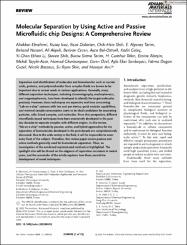Molecular Separation by Using Active and Passive Microfluidic chip Designs: A Comprehensive Review

Göster/
Erişim
info:eu-repo/semantics/openAccessTarih
2024Yazar
Ebrahimi, AliakbarIcoz, Kutay
Didarian, Reza
Shih, Chih-Hsin
Tarim, E. Alperay
Nasseri, Behzad
Akpek, Ali
Cecen, Berivan
Bal-Ozturk, Ayca
Gulec, Kadri
Li, Yi-Chen Ethan
Shih, Steven
Tarim, Burcu Sirma
Tekin, H. Cumhur
Alarcin, Emine
Tayybi-Azar, Mehdi
Ghorbanpoor, Hamed
Ozel, Ceren
Sariboyaci, Ayla Eker
Guzel, Fatma Dogan
Bassous, Nicole
Shin, Su Ryon
Avci, Huseyin
Üst veri
Tüm öğe kaydını gösterÖzet
Separation and identification of molecules and biomolecules such as nucleic
acids, proteins, and polysaccharides from complex fluids are known to be
important due to unmet needs in various applications. Generally, many
different separation techniques, including chromatography, electrophoresis,
and magnetophoresis, have been developed to identify the target molecules
precisely. However, these techniques are expensive and time consuming.
“Lab-on-a-chip” systems with low cost per device, quick analysis capabilities,
and minimal sample consumption seem to be ideal candidates for separating
particles, cells, blood samples, and molecules. From this perspective, different
microfluidic-based techniques have been extensively developed in the past
two decades to separate samples with different origins. In this review,
“lab-on-a-chip” methods by passive, active, and hybrid approaches for the
separation of biomolecules developed in the past decade are comprehensively
discussed. Due to the wide variety in the field, it will be impossible to cover
every facet of the subject. Therefore, this review paper covers passive and
active methods generally used for biomolecule separation. Then, an
investigation of the combined sophisticated methods is highlighted. The
spotlight also will be shined on the elegance of separation successes in recent
years, and the remainder of the article explores how these permit the
development of novel techniques.
Kaynak
ADVANCED MATERIALS INTERFACESCilt
11Sayı
2Koleksiyonlar
İlgili Öğeler
Başlık, yazar, küratör ve konuya göre gösterilen ilgili öğeler.
-
Separation of Fe and Mn from Manganiferous Iron Ores via Reductive Acid Leaching Followed by Magnetic Separation
Top, Soner (SPRINGER HEIDELBERG, TIERGARTENSTRASSE 17, D-69121 HEIDELBERG, GERMANY, 2020)In this study, a process to separate manganese and iron from manganiferous iron ores by reductive acid leaching followed by magnetic separation was conceived and experimentally tested. In the leaching process, sulfuric ... -
Immunomagnetic separation of B type acute lymphoblastic leukemia cells from bone marrow with flow cytometry validation and microfluidic chip measurements
Icoz, Kutay; Eken, Ahmet; Cinar, Suzan; Murat, Aysegul; Ozcan, Servet; Unal, Ekrem; Deniz, Gunnur (TAYLOR & FRANCIS INC, 530 WALNUT STREET, STE 850, PHILADELPHIA, PA 19106 USA, 2020)In order to detect the blast cells from bone marrow of patients, one strategy is to first isolate the cells using immunomagnetic beads. The aim of this study was to report the experimental results of the immunomagnetic ... -
The electronic and optical properties of an exciton, biexciton and charged excitons in CdSe/CdTe-based multi-shell type-II quantum dot nanocrystals
Koc, Fatih; Sahin, Mehmet (SPRINGER HEIDELBERG, TIERGARTENSTRASSE 17, D-69121 HEIDELBERG, GERMANY, 2019)It has been recently reported that multi-shell type-II quantum dot nanocrystals (QDNCs) have higher quantum yields. Besides these higher quantum yields of multi-shell type-II QDNCs, additional second layer has been a ...

















